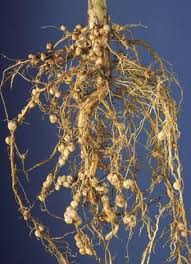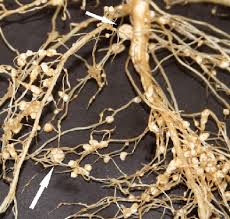Soybean Nodules: Economic Importance, Uses and By-Products
Soybean nodules are specialized structures that form on the roots of soybean plants (Glycine max) as a result of a symbiotic relationship between the plant and specific nitrogen-fixing bacteria called rhizobia. These nodules play a crucial role in the nitrogen cycle and contribute to the plant’s overall health and growth.
Soybean nodules develop in response to the presence of compatible rhizobia bacteria in the soil. These bacteria are capable of converting atmospheric nitrogen gas (N2) into a form that plants can use, namely ammonium ions (NH4+). This conversion process is known as nitrogen fixation.
Soybean nodules appear as small, round or oval-shaped structures attached to the roots of the plant. They range in size from a few millimeters to a couple of centimeters in diameter. Nodules are typically pale pink to reddish in color due to the presence of a pigment called leghemoglobin, which helps maintain an oxygen-free environment within the nodule—an important factor for effective nitrogen fixation.
The nodules are composed of plant cells and bacteria. Inside the nodules, specialized plant cells called “infected cells” house the rhizobia bacteria. These bacteria reside within the plant cells in structures called bacteroids, where they carry out nitrogen fixation.
The main function of soybean nodules is to facilitate the process of nitrogen fixation. Rhizobia bacteria within the nodules convert atmospheric nitrogen gas into ammonium ions, which can be utilized by the soybean plant as a nutrient. In return, the plant provides the bacteria with a suitable environment, including sugars and other organic compounds, for their growth and survival.
Soybean nodules play a critical role in sustainable agriculture by reducing the need for synthetic nitrogen fertilizers. The nitrogen-fixing capability of the nodules allows soybean plants to obtain a significant portion of their nitrogen requirement from the air, which can enhance soil fertility and minimize environmental pollution caused by excess fertilizer usage.
Soybean nodules are specialized structures that develop on the roots of soybean plants through a symbiotic relationship with rhizobia bacteria. They enable the conversion of atmospheric nitrogen into a usable form, benefiting both the plant and the surrounding environment.
The Economic Importance and Uses of Soybean Nodules

Soybean nodules play a crucial role in the growth and development of soybean plants, as well as in the broader context of agricultural and economic systems. These nodules form as a result of a symbiotic relationship between soybean plants and nitrogen-fixing bacteria known as rhizobia.
Here are the economic importance and uses of soybean nodules:
1. Nitrogen Fixation: The most significant economic importance of soybean nodules is their ability to fix atmospheric nitrogen into a form that plants can use. Nitrogen is a vital nutrient required for plant growth, and many plants, including soybeans, often face nitrogen deficiencies in the soil. The symbiotic relationship between soybean plants and rhizobia allows soybeans to access a continuous source of nitrogen, which can lead to increased plant growth, improved yield, and reduced dependence on synthetic nitrogen fertilizers. This benefits farmers by reducing input costs associated with fertilizers.
2. Yield Enhancement: Nitrogen fixation by soybean nodules leads to increased plant productivity and higher crop yields. The additional nitrogen from nodules helps the soybean plants develop healthy foliage, vigorous growth, and improved seed formation, all of which contribute to higher yields. Increased yield is a direct economic benefit for farmers, as it translates to more marketable products and potentially higher profits.
3. Reduced Environmental Impact: The use of soybean nodules for nitrogen fixation can lead to reduced reliance on synthetic nitrogen fertilizers. Excessive use of these fertilizers can contribute to environmental issues such as water pollution, greenhouse gas emissions, and soil degradation. By enhancing natural nitrogen fixation through soybean nodules, farmers can contribute to more sustainable agricultural practices and reduce the negative impact on the environment.
4. Crop Rotation and Soil Improvement: Soybeans are often used as a rotational crop in agricultural systems. Their ability to fix nitrogen enhances the soil’s fertility, benefiting subsequent crops in the rotation that require nitrogen. This can lead to improved soil health, structure, and nutrient availability, contributing to long-term sustainable land management.
5. Biological Nitrogen Fixation Research: The study of soybean nodules and their symbiotic relationship with rhizobia has contributed to advances in agricultural science. Researchers study the genetics, biochemistry, and physiology of these interactions to develop improved varieties of soybeans, as well as other leguminous crops, with enhanced nitrogen-fixing capabilities. This research has practical applications in developing more efficient and sustainable agricultural practices.
6. Seed Production: The development of soybean varieties with effective nodulation systems is essential for producing high-quality seeds. Farmers and seed producers prioritize selecting and breeding soybean varieties that exhibit strong nodulation and nitrogen-fixing abilities. Quality seeds with robust nodulation potential ensure consistent and reliable nitrogen fixation in the field, leading to better yields.
Read Also: Soybean Bracts: Economic Importance, Uses and By-Products
7. Biofertilizer Production: The rhizobia bacteria responsible for nitrogen fixation in soybean nodules can be isolated and used as biofertilizers for other crops. These biofertilizers can be applied to the soil to enhance nitrogen availability for various plants, reducing the need for synthetic fertilizers and promoting sustainable agriculture.
8. Livestock Feed and Food Industry: The economic impact of soybean nodules extends beyond crop production. Soybeans are a valuable source of protein in both animal feed and the food industry. The nitrogen-fixing capabilities of soybean nodules contribute to the high protein content of soybeans, making them an essential ingredient in livestock feed, poultry feed, and pet food. Additionally, soybeans are processed into various food products, including soybean oil, tofu, soy milk, and other soy-based foods, all of which benefit from the enhanced nutrient content attributed to nitrogen fixation.
8. Biofuel Production: Soybeans can be used for biodiesel production, and the nitrogen-fixing ability of soybean nodules contributes to their overall yield and growth. Sustainable soybean cultivation with effective nitrogen fixation leads to higher oil content in soybean seeds, which can be processed into biodiesel. The biofuel industry benefits from increased feedstock availability and efficient utilization of resources.
9. Trade and Economic Growth: Soybeans are one of the world’s major crops, and their cultivation contributes significantly to international trade and economic growth. Countries that are major exporters of soybeans, such as the United States, Brazil, and Argentina, can benefit economically from increased soybean production due to the role of nodules in enhancing yields and making soybeans a valuable commodity on the global market.
10. Research and Innovation: The study of soybean nodules and nitrogen fixation has broader implications for agricultural research and innovation. Understanding the complex interactions between plants and bacteria in the rhizosphere can lead to the development of novel agricultural practices, biotechnological applications, and sustainable farming techniques. This research has the potential to create new economic opportunities in areas like biotechnology, genetic engineering, and sustainable agriculture.
11. Agricultural Extension Services: Agriculture extension services and advisory programs often educate farmers about the benefits of nitrogen fixation and effective nodulation in soybeans. By promoting best practices for optimizing nodulation, these services help farmers enhance their yields and profits while reducing environmental impact. This knowledge dissemination contributes to the economic viability and sustainability of farming communities.
12. Global Food Security: The increased yield and productivity of soybeans through effective nitrogen fixation contribute to global food security. As the world’s population continues to grow, ensuring a stable and sufficient food supply becomes paramount. By utilizing soybean nodules’ potential to enhance crop yields, agricultural systems can produce more food to meet the needs of a growing population.
The Products and By-products That Can Be Derived From Soybean Nodules
Soybean nodules are specialized structures formed on the roots of soybean plants as a result of symbiotic relationships with nitrogen-fixing bacteria called Rhizobia. These nodules play a crucial role in fixing atmospheric nitrogen into a form that can be utilized by the plant. While soybean nodules are not typically directly harvested for commercial purposes, they contribute to the overall health and productivity of the soybean plant.
Here are some products and by-products that can be indirectly derived from soybean nodules:
1. Soybeans (Seeds): The primary agricultural product from soybean plants is the soybean seed itself. Soybeans are rich in protein, healthy fats, vitamins, and minerals. They have numerous applications in the food industry, including as a source of vegetable oil, protein-rich meal, and various soy-based food products.
2. Soybean Meal: After soybeans are processed for oil extraction, the remaining defatted soybean flakes are used to produce soybean meal. This by-product is a valuable source of protein and is commonly used as animal feed for livestock and poultry.
3. Soybean Oil: Soybean seeds contain a significant amount of oil, which is extracted through mechanical or chemical processes. Soybean oil is one of the most widely used vegetable oils in cooking and food production due to its relatively neutral flavor, high smoke point, and nutritional content.
4. Soy Lecithin: Soy lecithin is a by-product of soybean oil extraction. It is used as an emulsifier and stabilizer in various food and industrial applications, such as chocolate production, baked goods, and cosmetics.
5. Biofuels: Research is ongoing to explore the use of soybean oil as a feedstock for biodiesel production. Soybean oil can be converted into biodiesel through a process called transesterification, providing an alternative to fossil fuels.
Read Also: 10 Medicinal Health Benefits of Solanum aculeastrum (Sodom Apple)
6. Soy-based Food Products: Soybeans and soy derivatives are used to produce a wide range of food products, including tofu, tempeh, soy milk, soy-based meat substitutes, and various fermented soy foods.
7. Phytochemical Extracts: Soybeans contain phytochemical compounds such as isoflavones, which have been studied for their potential health benefits, including hormone regulation and antioxidant properties. These compounds can be extracted and used in dietary supplements and functional foods.
8. Fertilizer: While not directly a product of soybean nodules, the process of nitrogen fixation carried out by the symbiotic relationship between soybean plants and Rhizobia contributes to the nitrogen content of the soil, enhancing its fertility. This can reduce the need for synthetic nitrogen fertilizers in soybean cultivation and benefit subsequent crops.
9. Organic Matter: When soybean plants and their nodules decompose after harvest or are incorporated into the soil as cover crops, they contribute to organic matter content, improving soil structure, water-holding capacity, and nutrient availability.
In conclusion, soybean nodules offer a wide range of economic benefits and uses that extend beyond their immediate role in soybean growth. From enhancing crop yields and reducing fertilizer costs to promoting sustainable practices and supporting various industries, the significance of soybean nodules is deeply intertwined with modern agriculture, trade, and global sustainability efforts.
Read Also: Comprehensive Farm Startup Guide









